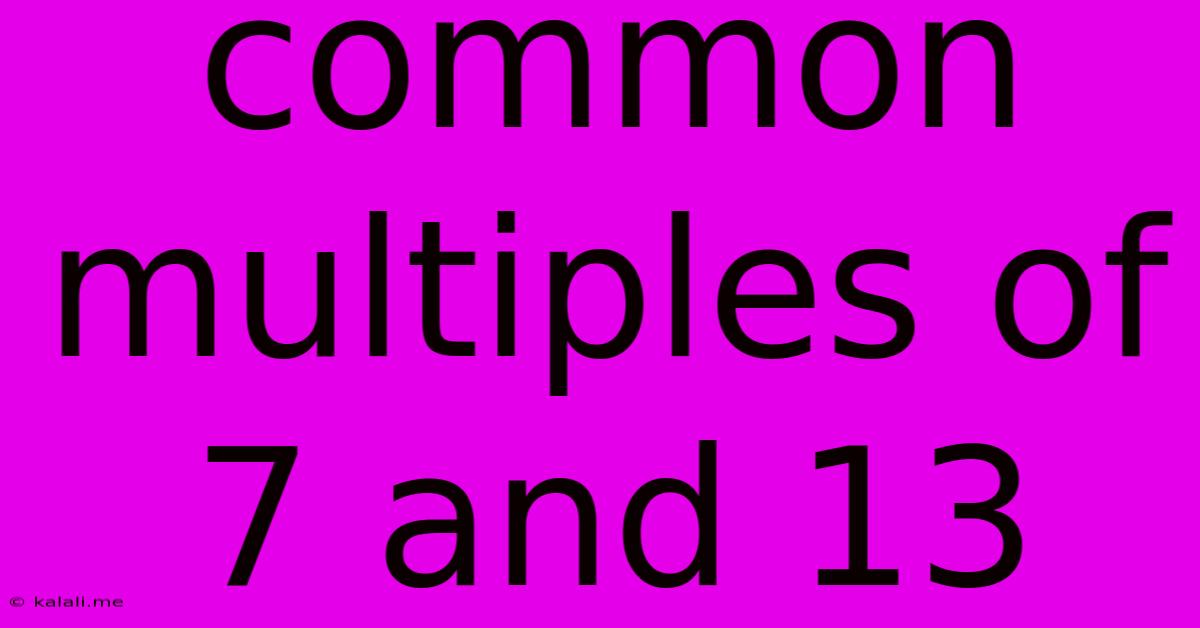Common Multiples Of 7 And 13
Kalali
Jun 13, 2025 · 3 min read

Table of Contents
Unveiling the Secrets of Common Multiples: 7 and 13
Finding common multiples, especially for seemingly unrelated numbers like 7 and 13, might seem daunting at first. But with a clear understanding of the underlying concepts and a few simple techniques, you'll master this mathematical skill in no time. This article will explore the world of common multiples, focusing specifically on the intriguing pair of 7 and 13, and provide you with practical strategies to determine them efficiently.
What are Common Multiples?
Before we dive into the specifics of 7 and 13, let's clarify the fundamental concept. A multiple of a number is the result of multiplying that number by any integer (whole number). For example, multiples of 7 include 7, 14, 21, 28, and so on. Multiples of 13 include 13, 26, 39, 52, and so forth.
A common multiple is a number that is a multiple of two or more numbers. In our case, we're searching for numbers that are multiples of both 7 and 13.
Finding the Least Common Multiple (LCM)
The Least Common Multiple (LCM) is the smallest positive number that is a multiple of both 7 and 13. This is often the starting point when working with common multiples. There are several ways to find the LCM:
Method 1: Listing Multiples
The simplest, albeit potentially time-consuming method, is to list the multiples of each number until you find a common one.
- Multiples of 7: 7, 14, 21, 28, 35, 42, 49, 56, 63, 70, 77, 84, 91, 98, 105...
- Multiples of 13: 13, 26, 39, 52, 65, 78, 91, 104, 117, 130...
Notice that 91 appears in both lists. Therefore, the LCM of 7 and 13 is 91.
Method 2: Prime Factorization
A more efficient method involves prime factorization. This involves breaking down each number into its prime factors (numbers divisible only by 1 and themselves).
- 7 is a prime number, so its prime factorization is simply 7.
- 13 is also a prime number, so its prime factorization is 13.
To find the LCM, we multiply the highest powers of all prime factors present in either factorization. In this case, we have 7 and 13, so the LCM is 7 x 13 = 91.
Method 3: Using the Formula (for two numbers)
For two numbers, a and b, the LCM can be calculated using the formula: LCM(a, b) = (|a * b|) / GCD(a, b), where GCD represents the Greatest Common Divisor.
Since 7 and 13 are prime numbers and share no common factors other than 1, their GCD is 1. Therefore, LCM(7, 13) = (7 * 13) / 1 = 91.
Finding Other Common Multiples
Once you've found the LCM (91), finding other common multiples is straightforward. Simply multiply the LCM by any integer. For instance:
- 91 x 2 = 182
- 91 x 3 = 273
- 91 x 4 = 364
- and so on...
Therefore, the common multiples of 7 and 13 are 91, 182, 273, 364, and infinitely many more.
Conclusion:
Understanding common multiples, particularly finding the LCM, is a crucial skill in various mathematical applications. By employing the methods outlined above – listing multiples, prime factorization, or the formula – you can efficiently determine the common multiples of any two numbers, including the seemingly simple yet instructive case of 7 and 13. Remember, the key is to choose the method that best suits your comfort level and the complexity of the numbers involved.
Latest Posts
Latest Posts
-
Least Common Multiple Of 25 And 40
Jun 13, 2025
-
This Is Also Known As Torque Multiplication
Jun 13, 2025
-
Lcm Of 7 3 And 4
Jun 13, 2025
-
How Many Rectangles Are In The Figure Below
Jun 13, 2025
-
Which Of The Following Statements About Genes Is Not Correct
Jun 13, 2025
Related Post
Thank you for visiting our website which covers about Common Multiples Of 7 And 13 . We hope the information provided has been useful to you. Feel free to contact us if you have any questions or need further assistance. See you next time and don't miss to bookmark.